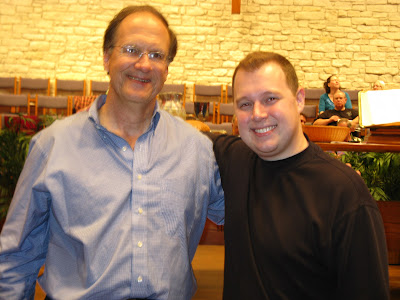Composer Robert Kyr, Musical Director Ryan Heller
11/8/10--Last night's rehearsal was at the Oak Hill United Methodist Church in the sanctuary where we will perform. It went well, the group really pulling together. Very comforting to get a feel for the acoustics--how to listen and how to produce sound for that space. The Very Big Deal, however, was Tuesday night's rehearsal.
11/9/10--Composer Robert Kyr, whose "Let There Be Music" is featured on the program, worked with the ensemble this evening, and will be in attendance both performances. He was most enthusiastic about the preparation we'd done under the direction of Ryan Heller, AVAE's musical director.
We had an exhaustive, exhausting, fabulous time regrouping to the physical architecture of the piece. He gave us valuable insight into the piece on common ground and supercharged the response of the chorus. Kyr, professor of composition and theory at the University of Oregon, morphed rehearsal into a master class.
Firstly, we did a few minutes of yoga, although he didn't call it that. Progressive upward stretches to release the tension in the vocal mechanism to produce our best sound. And that it did. I think we all listened "with bigger ears," as Ryan said, and certainly put that piece (mostly--a few things to work out Thursday) where it needs to go. I love working with composers--and they love hearing their work done the way they want it done. And done, in Watermelon Sugar.
From Kyr: "overtones are the DNA of music..." "think of a double helix when you sing these interweaving lines..." let there be music--let there be light--let there be breath." The piece is quite sonorous. It is also quite visual. It will be a great treat for everyone, audience and performers alike.
Regrouping the architecture: Yes, we physically did this--moved the ensemble right out front in 2 lines, with the various voice sections re-positioned. Kyr explained the specific structures to the group, and placed sections that interweave closer together. It makes sense in this piece. We learned what to listen for, and we listened better. And the closer we are to the audience, the more involved they will be.
That's what music is, after all. Equal parts listening and singing/performing. It's the magic of chamber ensembles. The most interesting (to me) choral music and certainly the biggest challenge. I'd like to see all my friends and relatives there, and lots of new folks who love music and are interested to hear a fabulous ensemble perform wicked-good stuff.
Visit Chorus Austin for concert details and tickets.
11.10.2010
Subscribe to:
Post Comments (Atom)










0 comments:
Post a Comment